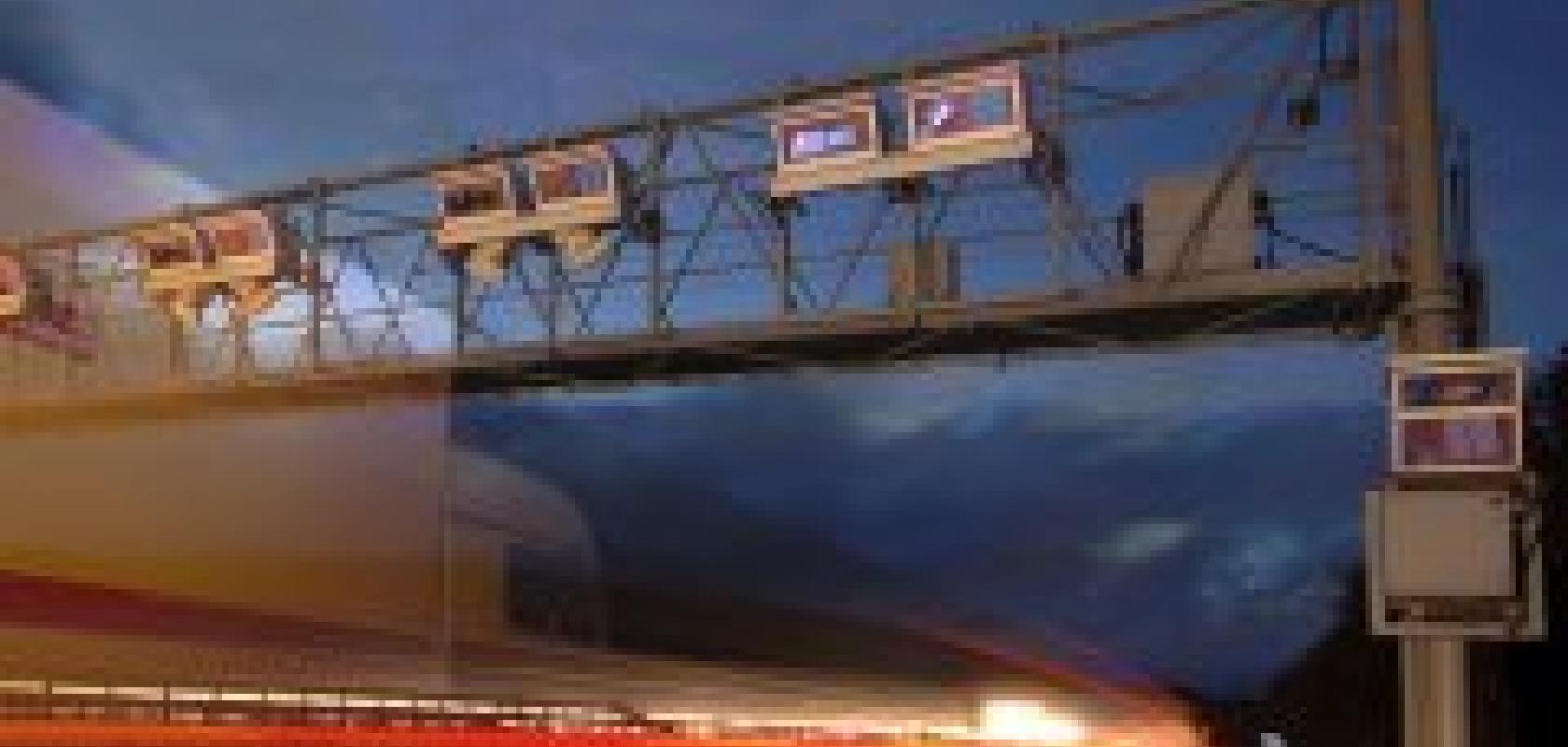Analogue video technology has long been used for monitoring transport networks and is still widely used today. However, there is an increasing move towards using digital machine vision technology in certain applications, due to the additional functionality it provides. ‘Vision for traffic monitoring is currently split between CCTV and pure machine vision systems,’ states Steve Hearn, sales manager at European imaging technology provider Stemmer Imaging. The cameras used in a traditional, machine vision environment don’t require excessive functionality. However, for traffic monitoring applications a certain amount of pre-processing functionality is required. The need to control a lens, for instance, means that digital cameras for traffic monitoring are designed with similar functionality to that of analogue cameras and with technology, such as FPGAs, a level of image pre-processing is possible.
‘CCTV is low-cost and generally well established for traffic monitoring,’ says Hearn. However, he goes on to say, the cameras are limited in resolution, and coverage of two to three lanes of traffic with one camera is not possible with most CCTV systems. Machine vision cameras provide higher resolution and also triggering capability, so systems do not need to continuously record, as is the case with CCTV, but can be triggered to capture specific images.
Transport for London (TfL) is in the process of upgrading the city’s analogue traffic enforcement system to a digital system. Systems Engineering and Assessment, a UK-based systems integrator, is developing the Digital Traffic Enforcement System (DTES) using Ticket Express management software and traffic enforcement systems from Danish vision technology company JAI.
The DTES project aims to improve the efficiency and reduce the cost of collecting, processing and storing traffic offence evidence. Areas such as bus journey times, bus reliability, congestion, and road safety, are targeted for improvement by the scheme. TfL’s current system uses continuously recording analogue video cameras, whereas DTES is designed to detect and record only contraventions – thus eliminating the need for reviewing hours of unnecessary footage and the necessity for large storage facilities.
One of the challenges for machine vision cameras used in traffic monitoring applications is producing high-resolution images in low light conditions. With higher-resolution sensors the sensitivity is lower, so additional lighting is required. However, the sensitivity of image sensors is increasing rapidly, with manufacturers such as Dalsa designing sensors with improved sensitivity in the near-infrared region.
On the software side, machine vision technology can add intelligence to the images captured. Automatic number plate recognition (ANPR) is a classic example, and image analysis tools can be used to not only read the number plate, but also to classify criteria such as make, model and colour of the vehicle.
‘Adding a degree of intelligence to the images captured lends itself to certain traffic monitoring applications, such as automatic tolling schemes and restricting certain vehicles from certain areas,’ notes Hearn. For instance, a restriction might be placed on heavy vehicles in the city centre during peak traffic times and ANPR can help enforce that. Security is another example, where cameras can monitor roads and flag up stolen cars or vehicles wanted by the police.

A traffic scheme set up on Dutch roads advising motorists of the travelling times of different routes. Image courtesy of Sony and Abstract Computing International.
Dutch company VID provides national traffic information in the Netherlands and has implemented Sony’s smart camera with ANPR capability for use in various applications on Dutch roads. The software involved was developed by Abstract Computing International, a Dutch company that designs software and video analysers for object recognition.
VID has implemented a number of traffic monitoring schemes using the smart camera. One such scheme advises motorists of the respective travelling times of different routes. A camera is placed at the intersection between two routes and monitors car number plates, sending the information to a central server. Separate cameras are set up further along both routes, carrying out the same task. When the server registers a match it can calculate the time taken for the car to travel from the first to the second camera. The information flashes up on a road sign providing the driver with up-to-the-minute travel times for different routes.
‘One of the main advantages of the smart camera is its flexibility and its ability to be easily moved and set up in different positions,’ explains Allard Blom, chief operating officer at Abstract Computing International. ‘Power consumption is low, and the cameras can operate on a combination of using the power from public lighting during the night and battery power during the day.’
Sony’s cameras are also used to restrict queue-hopping at petrol stations and other rat-runs, where motorists are prone to drive through to avoid queuing. Cameras are set up at the entrance and exit to the compounds; the number plate is read at both ends and if the time interval is too short between entering and exiting, a red light will force the car to wait.
A third application is to ensure high-sided vehicles leave the road when approaching a low bridge. The standard safety method for this scenario is to have a set of traffic lights that turn red and stop the traffic if a lorry approaches that is too high. Sony’s smart cameras have been implemented to measure the height of trucks using a laser-based system, and flash up a warning on a road sign telling the driver to leave at the next exit. A second camera is then positioned on the exit ramp to register if the truck leaves the road. If the system doesn’t register the truck leaving the road, the traffic lights are activated and the traffic stopped.
‘For each application, the flexibility of the cameras to be moved to different positions and combat local traffic conditions is a big advantage,’ says Blom. ‘Other ANPR cameras can be more restrictive in positioning.’
ANPR lends itself very well to setting up automatic tolling schemes. TollChecker systems from Vitronic, a global manufacturer of industrial image processing systems, are designed for this purpose, and are generally more complex than the company’s PoliScan systems – also incorporating ANPR and aimed at traffic enforcement. ‘Automated toll systems require more information about the vehicle than just the number plate, as often vehicle types – cars, trucks, motorbikes, etc – will be charged different amounts,’ comments Daniel Scholz, international sales manager at Vitronic. ‘The toll plaza, where cars are forced to stop and pay a fare, is no longer a modern solution to a toll system,’ says Scholz. TollChecker Freeflow provides a single-gantry solution that doesn’t interfere with traffic, thereby reducing congestion and improving safety – vehicles switching lanes when approaching a toll plaza can be a source of accidents.
Vitronic’s systems use cameras manufactured in-house, and lidar technology to trigger the camera. As well as security and tolling applications, ANPR can also be used for speed enforcement. By capturing the time taken between two or three points, the average speed can be determined and violators captured. ‘ANPR and lidar technology are considered much more accurate than radar-based detection, which can have limitations when vehicles are driving in parallel over multiple lanes,’ explains Scholz. The systems also use LED infrared high-power flashes, which are invisible to the driver and produce high quality images.
Infrared light reflected from passing vehicles can also be used as a trigger. JAI’s IIT (In-Image Triggering) Camera System uses this technology, which is more reliable than software-based triggerless traffic and transport systems and eliminates the need for installing ground loops.
‘The reliability and accuracy of the system is of paramount importance, as it is collecting sensitive data,’ states Scholz.
Blom of Abstract Computing International agrees: ‘The first challenge with developing an ANPR system is finding the number plate, as colour, size, position, as well as the body text will differ with different licensing schemes.’ Once the software has recognised the number plate, optical character recognition (OCR) is used to read the text. ‘In order for the plate to be read accurately the picture must be of a high enough resolution for the text to be identified by the OCR software,’ he says.
However, Scholz notes that several medium resolution cameras provide sufficient image quality for the software to read the number plate over multiple lanes without having to deal with the large amounts of data involved with higher resolution cameras. He adds: ‘It’s not just the resolution that’s important, but the entire dynamics of the camera, as the technology has to handle factors such as glare from direct sunlight and vehicle headlights.’
‘Currently, the main limitation for ANPR concerns data protection and many European countries are not using ANPR on their roads for this reason,’ says Scholz. ‘However, the ability to provide speed enforcement information gives a big boost to the technology, and, in Germany as well as in other European countries, ANPR is a growing market sector.’
Hearn of Stemmer Imaging suggests a final challenge for machine vision companies targeting the traffic and transport market: ‘The real challenge is for technology companies to understand what users require from machine vision, and for users to understand what technology companies can supply. It’s only through machine vision companies talking to potential customers in the traffic sector that the use of digital camera technology will increase.’


